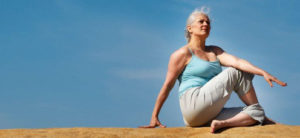
A wise sage was once asked (probably more than once), “What is the purpose of life?” His reply: “Growth.”
As we know, the cycles of life always bring inevitable change. Nothing ever remains static or the same, though sometimes we wish it would. Most of us see the cycle of our aging as a process of gradually falling apart. Yet on so many levels, the aging process becomes one of continual personal expansion and discovery. A lifetime of experience can lead to deeper wisdom and a profound honoring of this process. The body and all its functions can continue to thrive throughout your time on this earth!
I see that my own asana practice has shifted over the years. When I was younger, it was all about achieving the difficult, showy poses. I felt that my practice reflected my commitment to the practice and saw it as a definitive expression of progress. On a certain level that may have been true. I think the physical challenge is probably what initially attracted me and kept my interest. Yet I grew to see that for me that type of physical practice was unsustainable and was very much connected to my sense of self-worth. My approach of always wishing to achieve more in my poses took focus away from many of yoga’s other teachings imbedded in mediation, pranayama, and study of spiritual texts.
I now look at my practice with a long term perspective. How will it be five, ten, twenty, thirty years down the road? How can the way I practice not only continue to strengthen, open and balance my body, but how can I use all the varied aspects of yoga practice to evolve my consciousness. Our body has its limits, even when young, but our capacity for compassion, forgiveness, love, learning and understanding are virtually infinite.
What Practice Looks Like Over Fifty?
As the years go by, yoga practice will be as varied as the people doing it. But there are specific things to bear in mind. Of course, yoga practice over 50 will initially be different depending on whether you’ve already been practicing for years or are coming to it for the first time. Either way, the benefits are the same: Increased muscular strength, range of motion, joint integrity, coordination, balance, body fat reduction and maintenance of bone density. If pranayama is practiced regularly, lung function is maintained or improved. Also brain and nerve function are improved including cognitive function.
Below are some facts about aging that are true for everyone. And the consistent practice of yoga addresses all of them!
A few proven facts about aging and your body
As your body ages, you can expect gradual changes, at your body’s own pace. How your body ages depends in part on your family (genetic) patterns of aging. But your lifestyle choices have a more powerful impact on how well your body ages. Those choices are completely within your control.
It’s proven that frequent physical activity improves fitness, both of the body and the mind. Over time the body adapts and becomes stronger. Physiological changes to the respiratory, cardiovascular, musculoskeletal, and cognitive systems occur during exercise and add up to long term benefits to health and wellness.
Bones – Throughout adulthood, men and women gradually lose some of the mineral content in their bones. The bones get less dense and strong. You can slow natural bone loss and reduce your risk of osteoporosis by getting regular, weight-bearing exercise (that includes yoga!), as well as getting enough calcium and vitamin D.
Metabolism and body composition – Over time, the body typically needs less energy, and your metabolism slows. Hormone changes in the aging body result in a shift to more body fat and less muscle mass. The best approach to managing these changes is to take in fewer calories while keeping up or increasing your physical activity. Strength training is an especially good way to build or keep your muscle mass. When your muscle mass is reduced, your metabolism slows down. Building or keeping your muscle mass allows your metabolism to remain the same or increase.
Brain and nervous system – Starting in the third decade of life, the brain’s weight, the size of its nerve network, and its blood flow decrease. But the brain adapts to these changes, growing new patterns of nerve endings (synapses). Memory changes are a normal part of the aging process. It’s common to have less recall of recent memories and to be slower remembering names and details. You can help keep your brain sharp. Engage in regular social activity, challenge yourself to learn and do new things, and be physically active to increase blood and oxygen flow to the brain.
Heart and blood circulation – The heart naturally becomes less efficient as it ages, and your heart has to work a little harder during activity than it did in the past. This makes the heart muscle a little larger. You’ll notice a gradual decline in your energy or endurance from one decade to the next. The regular practice of yoga postures, pranayama and mediation can help mitigate this trend.
Lungs – In inactive people, the lungs become less efficient over time, supplying the body with less oxygen. Regular physical activity plays a key role in keeping your lungs strong. Breathing exercises (pranayama) go a long way to maintaining lung capacity and elasticity.
Healing – Yoga has a long history of healing us on many levels. Consistent, knowledgeable practice can go a long way to healing our aches and pains and help prevent new ones.
Practice and enjoy life. It can always be better!

Recent Comments